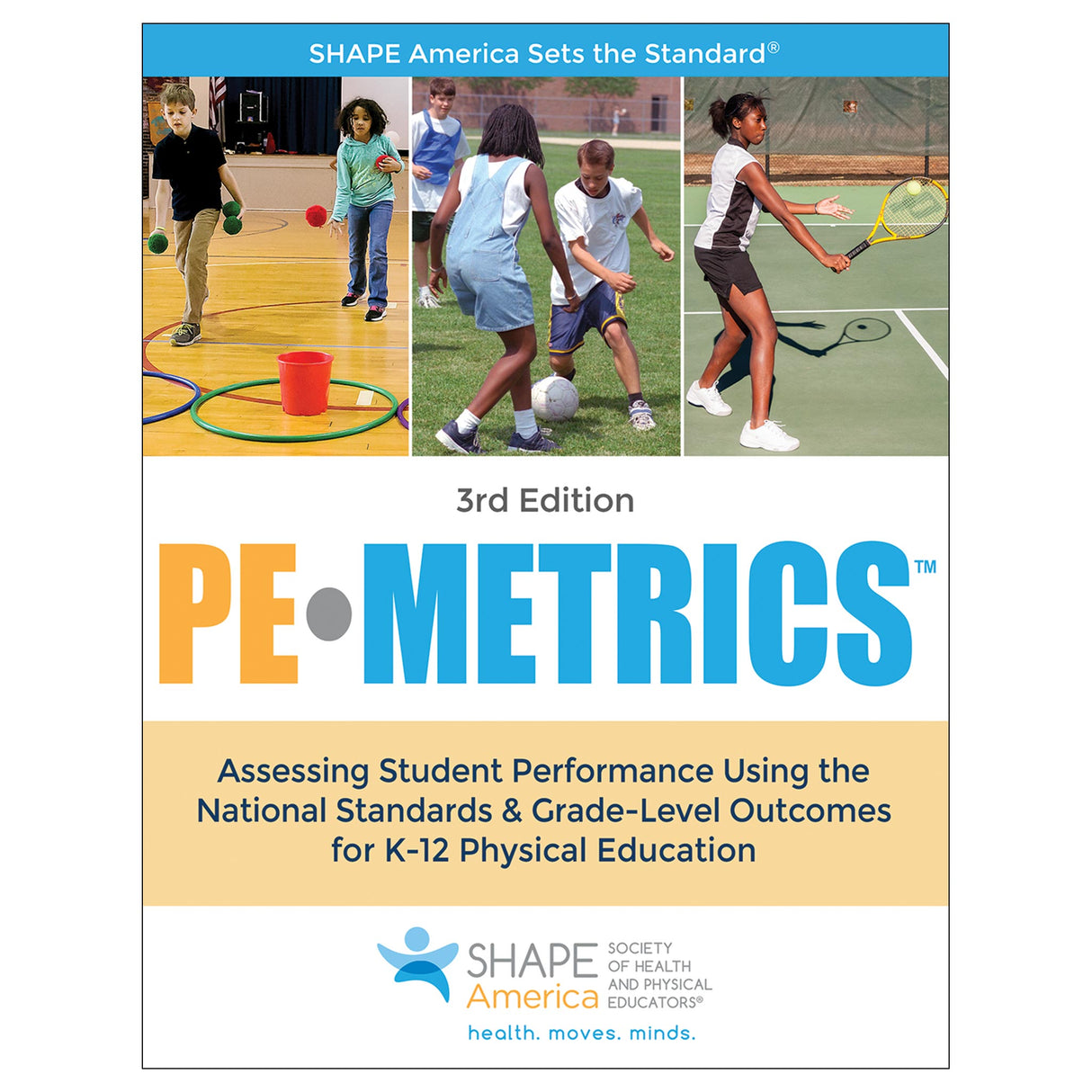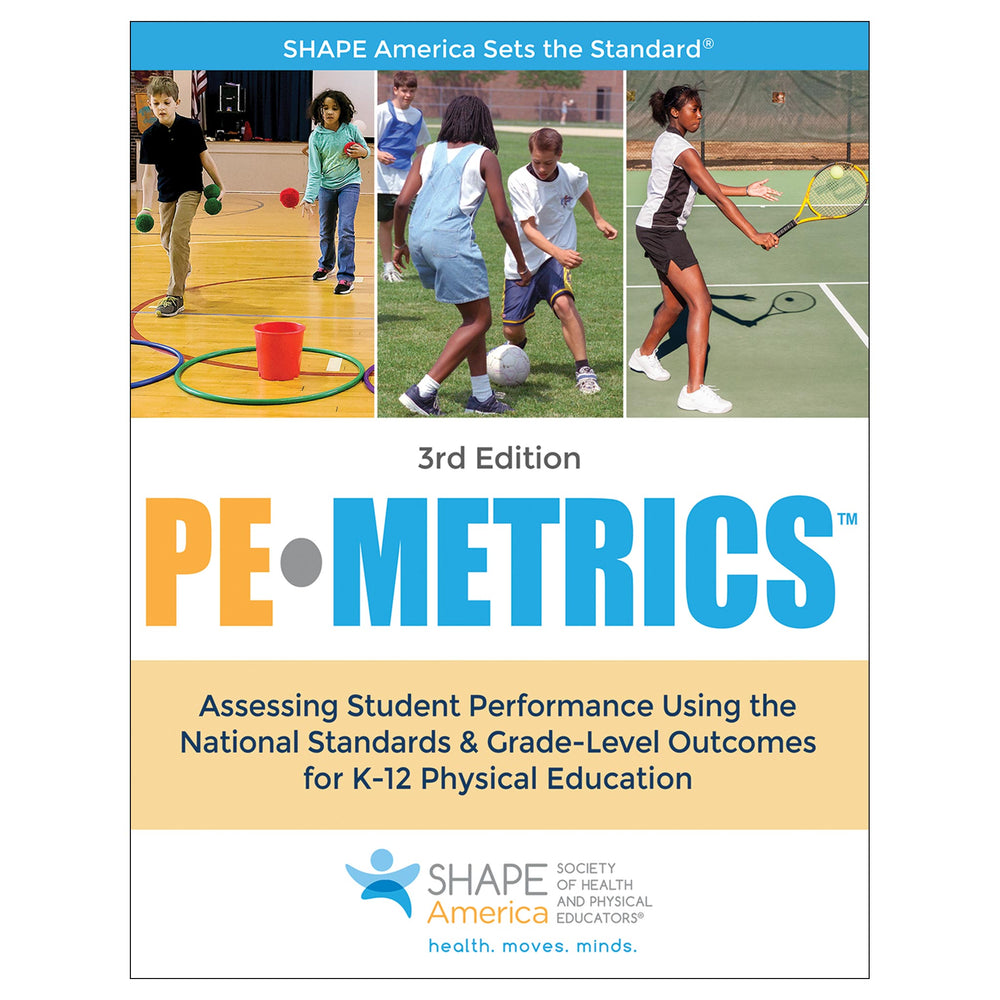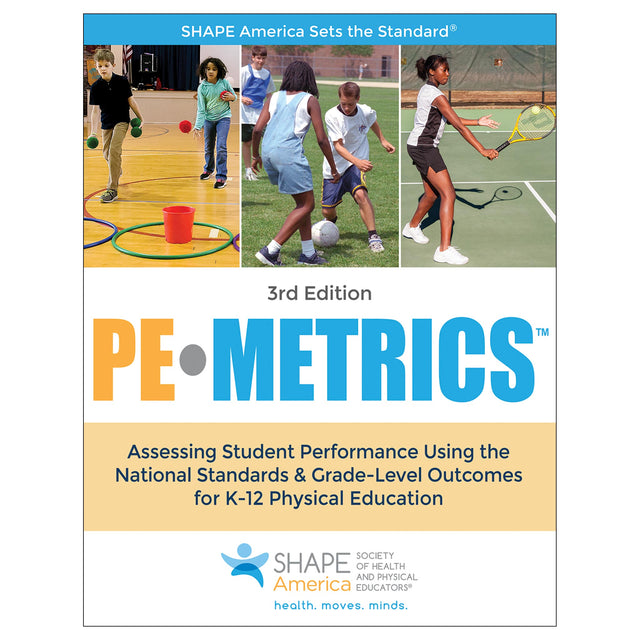PE Metrics 3rd Edition
Assessing Student Performance Using the National Standards & Grade-Level Outcomes for K-12 Physical Education
$72.00 USD
If you are looking for the definitive resource to help you measure your students’ achievement, your search is over.
PE Metrics: Assessing Student Performance Using the National Standards & Grade-Level Outcomes for K-12 Physical Education, Third Edition, aligns with SHAPE America’s National Standards and Grade-Level Outcomes for K-12 Physical Education, was created by SHAPE America and its writing team, and was reviewed by researchers and teachers with expertise in assessment. The result is a text that you can use with confidence as you help develop physical literacy in your students.
Written for physical educators, administrators, and curriculum writers (and for physical education majors and minors), this latest edition offers the following:
• 130 ready-to-use assessments for kindergarten through grade 12 (65 elementary, 43 middle school, and 22 high school)
• Worksheets, checklists, and rubrics that support the assessments
• Guidance on creating your own assessments for any lesson or unit
These assessments are aligned with the three SHAPE America lesson planning books for elementary, middle, and secondary school and dovetail with SHAPE America’s The Essentials of Teaching Physical Education. The assessments can be used as they are, or you can modify them or use them as samples in creating assessments that are best suited to your needs.
PE Metrics, now in a four-color design, is organized into four main parts: Part I introduces the purpose and uses of assessment, how to develop an assessment plan, and the various types of assessments and tools you can use. Part II contains sample assessments for students in grades K-5, focusing on fundamental motor skills; as such, the elementary-level assessments center heavily on Standard 1. In part III, the emphasis shifts to middle school assessments, with a concentration on Standard 2 and on the categories of dance and rhythms, invasion games, net/wall games, fielding/striking games, outdoor pursuits, aquatics, and individual-performance activities. Part IV offers sample assessments for high school students, with a priority on providing evidence of the knowledge and skills students will need to remain active and fit after they leave high school.
This resource provides a comprehensive, performance-based assessment system that enables you to incorporate assessment into every facet of your teaching, create assessments that are unique to your program, and measure your students’ performance against the grade-level outcomes. The assessments are process focused and are designed to measure multiple constructs as well as provide meaningful feedback to students—ultimately helping them to develop holistically across all three learning domains (psychomotor, cognitive, and affective).
PE Metrics will help you instill in students the knowledge, skills, and confidence they need to enjoy a lifetime of healthful physical activity.
Human Kinetics is proud to publish this book in association with SHAPE America, the national organization that defines excellence for school-based health and physical education professionals across the United States.
Audience
Resource for K-12 physical education teachers and administrators. Textbook for undergraduate physical education courses.
Part I. Assessment for the 21st Century
Using PE Metrics
Aligning PE Metrics With the National Standards and Grade-Level Outcomes
Assessing 21st Century Skills in Physical Education
Providing Student Choice
Organization of This Edition of PE Metrics
Using PE Metrics in Your Program
Final Thoughts
Assessment Essentials
The Role of Assessment in Today’s Schools
Purposes of Assessment
Using Observation for Assessment
Categories of Assessments
Assessment Tools
Assessing Complex Assignments (Projects or Portfolios)
Developing an Assessment Plan
Summary
Part II. Sample Assessments for Elementary School Physical Education
Standard 1 Sample Assessments
Hopping (Grade 1)
Sliding (Grade 1)
Galloping (Grade 1)
Skipping (Grade 2)
Running (Grade 2)
Throwing With an Underhand Pattern (Grade 2)
Jumping Rope (Grade 2)
Leaping (Grade 3)
Jumping and Landing – Horizontal Plane (Grade 3)
Jumping and Landing – Vertical Plane (Grade 3)
Balance in Gymnastics (Grade 3)
Transferring Weight in Gymnastics (Grade 3)
Throwing – Overhand Pattern (Grade 4)
Catching (Grade 4)
Dribbling With Hands (Grade 4)
Kicking Along the Ground (Grade 4)
Kicking in the Air (Grade 4)
Punting (Grade 4)
Volleying – Underhand Pattern (Grade 4)
Striking With Short-Handled Implements, Sidearm Pattern (Grade 4)
Striking a Pitched Ball With a Long-Handled Implement (Grade 5)
Balances and Weight Transfer in a Gymnastics Sequence (Grade 5)
Dance – Design and Performance (Grade 5)
Passing and Receiving With Feet (Grade 5)
Standard 2 Sample Assessments
Space Awareness, Levels (Grade K)
Pathways (Grade K)
Directions (Grade K)
Levels With Travel (Grade 1)
Speed With Travel (Grade 1)
Force (Grade 1)
Combining Shapes, Levels, Pathways in a Sequence (Grade 2)
Recognizing and Moving Into Open Spaces Using Pathways and Speed (Grade 3)
Identifying Locomotors in a Physical Activity (Grade 3)
Applying the Concept of Open Spaces to Dribbling (Grade 4)
Applying Concepts of Direction and Force When Striking With a Short-Handled Implement (Grade 4)
Applying Movement Concepts to Strategy in Game Situations (Grade 5)
Applying Concepts of Directions and Force to Striking With a Long-Handled Implement (Grade 5)
Combining Spatial Concepts With Locomotor and Nonlocomotor Movements in Dance (Grade 5)
Combining Movement Concepts With Skills in Gymnastics (Grade 5)
Standard 3 Sample Assessments
Physical Activity Knowledge (Grades K-1)
Fitness Knowledge (Grade 2)
Fitness Knowledge (Grade 3)
Pre-Assessment of Fitness Knowledge (Grade 3)
Physical Activity Opportunities (Grade 4)
Fitness Assessment – Knowledge (Grade 4)
Using Fitness Assessment Results to Identify Improvement Strategies (Grade 4)
Fitness Knowledge (Grade 5)
Designing a Personal Fitness Plan (Grade 5)
Standard 4 Sample Assessments
Personal Responsibility (Grades K-1)
Personal and Social Responsibility – Working With a Partner (Grade 2)
Personal Responsibility – Safety (Grade 3)
Personal Responsibility – Safety (Grade 3)
Personal and Social Responsibility – Safety (Grade 4)
Personal Responsibility (Grade 4)
Personal and Social Responsibility – Safety (Grade 4)
Personal and Social Responsibility (Grade 5)
Striking With a Long Implement (Grade 5)
Gymnastics Sequence (Grade 5)
Dance (Grade 5)
Games Strategy (Grade 5)
Standard 5 Sample Assessments
Enjoyment (Grades K-1)
Enjoyment, Challenge (Grade 2)
Challenge, Enjoyment (Grade 3)
Examining Health Benefits and Social Interaction in Physical Activity (Grade 4)
Enjoyment, Challenge, Self-Expression, Social Interaction (Grade 5)
Part III. Sample Assessments for Middle School Physical Education
Standard 1 Sample Assessments
Throwing in Invasion and Fielding/Striking Games (Grade 6)
Passing and Receiving (Grade 6)
Offensive Skills in Invasion Games (Grade 6)
Offensive Skills in Invasion Games (Grades 6-8)
Dribbling and Passing With Foot in Invasion Games (Grades 6-7)
Invasion Games – Shooting on Goal (Grade 8)
Invasion Games – Defensive Skills (Grade 6)
Invasion Games – Defensive Skills (Grade 7)
Invasion Games – Defensive Skills (Grade 8)
Net/Wall Games – Striking (Grade 7)
Striking in Net/Wall Games (Grade 7)
Net/Wall Games – Forehand and Backhand (Grade 8)
Net/Wall Games – Weight Transfer (Grade 6)
Net/Wall Games – Weight Transfer (Grade 7)
Net/Wall Games – Weight Transfer (Grade 8)
Net/Wall Games – Underhand Throw (Grade 8)
Fielding/Striking Games – Catching (Grade 8)
Outdoor Pursuits (Grade 8)
Individual-Performance Activities (Grade 8)
Dance and Rhythms (Grade 6)
Standard 2 Sample Assessments
Invasion Games – Creating Space With Movement (Grade 8)
Invasion Games – Creating Space With Offensive Tactics (Grade 8)
Invasion Games – Transitions (Grade 8)
Net/Wall Games – Using Tactics and Shots (Grade 8)
Target Games – Shot Selection (Grade 8)
Fielding/Striking Games – Reducing Space (Grade 8)
Individual-Performance Activities, Dance and Rhythms – Movement Concepts (Grade 8)
Outdoor Pursuits – Movement Concepts (Grade 6)
Standard 3 Sample Assessments
Physical Activity Knowledge (Grade 8)
Engages in Physical Activity (Grade 8)
Engages in Physical Activity (Grades 6-8)
Fitness Knowledge (Grade 8)
Fitness Knowledge (Grade 7)
Fitness Knowledge (Grade 6)
Fitness Knowledge (Grade 6)
Assessment and Program Planning (Grade 8)
Standard 4 Sample Assessments
Working With Others (Grade 6)
Working With Others (Grade 8)
Personal Responsibility (Grade 6)
Rules and Etiquette (Grade 8)
Standard 5 Sample Assessments
Health (Grade 7)
Challenge (Grade 8)
Self-Expression and Enjoyment (Grade 8)
Part IV. Sample Assessments for High School Physical Education
Standard 1 Sample Assessments
Lifetime Activity – Tennis (Level 1)
Lifetime Activity – Tennis (Level 1)
Lifetime Activity – Golf (Level 1)
Lifetime Activity – 2 v 2 or 3 v 3 Volleyball (Level 1)
Dance and Rhythms – Creative or Modern Dance (Level 1)
Dance and Rhythms – Folk, Square, and Line Dance (Level 1)
Fitness Activities – Yoga (Level 1)
Standard 2 Sample Assessments
Movement Concepts, Principles and Knowledge (Level 1)
Movement Concepts, Principles and Knowledge (Level 1)
Movement Concepts, Principles and Knowledge (Level 1)
Movement Concepts, Principles and Knowledge (Level 1)
Standard 3 Sample Assessments
Assessment and Program Planning (Level 2)
Assessment and Program Planning (Level 1)
Engages in Physical Activity (Level 1)
Nutrition (Level 1)
Assessment and Program Planning (Level 1)
Standard 4 Sample Assessments
Rules and Etiquette, Working With Others (Level 1)
Working With Others (Level 1)
Working With Others (Level 1)
Standard 5 Sample Assessments
Health (Level 1)
Self-Expression and Enjoyment (Level 1)
Self-Expression and Enjoyment (Level 1)
Appendixes
Appendix A: National Standards and Grade-Level Outcomes
Appendix B: Rubric With Weighted Values by Level
Appendix C: Rubric With Weighted Values by Indicator
Appendix D: Analytic Rubric With More Than One Standard (Embedded Assessment)
Appendix E: Suite of Assessments for Fitness Portfolio
Appendix F: Sample Score Sheets
Appendix G: Pre-Assessment With Wordle
Appendix H: Exit Slip Examples
Appendix I: Identifying Locomotors in Physical Activities
Appendix J: Embedded Analytic Rubric With Passing and Receiving and Game Strategy
Appendix K: Peer Assessment for Striking With Force and Direction
Appendix L: Exit Slip
Appendix M: Self-Assessment of Physical Activity Patterns
Appendix N: Elementary Personal Fitness Plan
Appendix O: Self-Assessment of Physical Activity Rating Scale
Appendix P: Analysis of Physical Activity at the Elementary Level (S5.E3.5)
Appendix Q: Frequency Count for Striking – Middle School
Appendix R: Peer Assessment for Shot Selection and Location – Middle School
Appendix S: Physical Activity Log Time Recording – Middle School
Appendix T: Physical Activity Log for Step Count – Middle School
Appendix U: Worksheets on Fitness – High School
Appendix V: Nutrition Log – High School
Appendix W: Fitness Plan Template – High School
Appendix X: Written Examination Sample – High School
Appendix Y: Fitness Contract – High School
Appendix Z: Goal Setting – High School
The Role of Assessment in Today's Schools
Using PE Metrics in Your Program
Human Kinetics is pleased to partner with SHAPE America by offering discounts on our resources to SHAPE America members! Whether you’re a preK-12 teacher, higher education faculty member, researcher, administrator, or future professional, we’re here to help you in your professional career and personal fitness journey of improved fitness, stronger athletic performance, and better nutrition.
SHAPE America members receive a 30% discount on this resource and other eligible resources through the member portal at SHAPE America. Learn more about SHAPE America membership at SHAPEAmerica.org or direct your questions about the discount to askmembership@shapeamerica.org.





